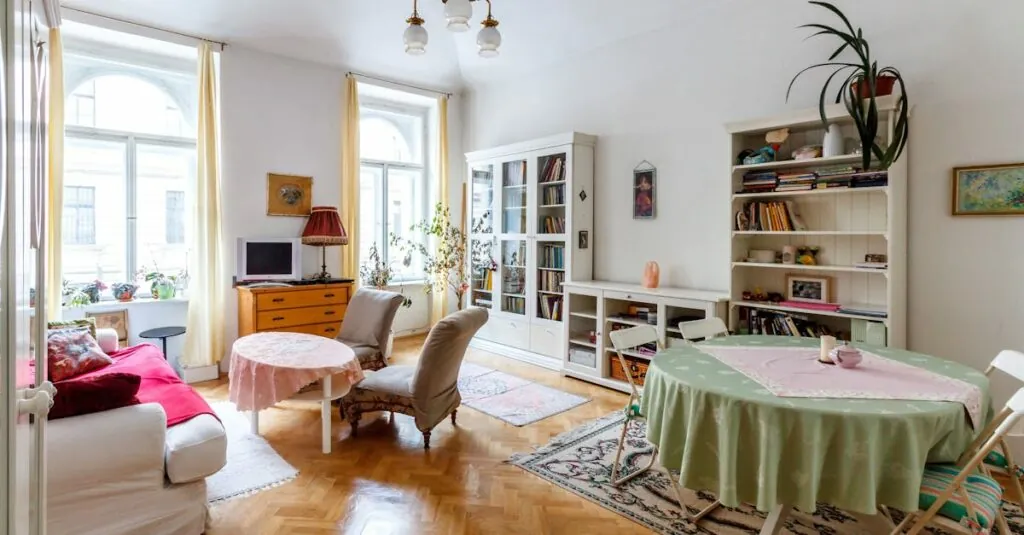Table of Contents
ToggleTransforming a living room into a cozy haven often starts with one magical element: the area rug. It’s like the cherry on top of a sundae, but instead of calories, it adds warmth and style. Whether it’s a bold pattern that screams personality or a subtle texture that whispers elegance, the right rug can elevate any space from drab to fab faster than you can say “Where’s the remote?”
Imagine sinking your toes into a plush rug while sipping coffee or hosting friends for game night. It’s not just about aesthetics; it’s about creating an inviting atmosphere where memories are made. Area rugs can tie together your decor, define spaces, and even muffle those awkward moments when the silence gets a little too loud. So, let’s dive into the world of living rooms with area rugs and discover how to make your space feel like home.
The Importance of Area Rugs in Living Rooms
Area rugs play a crucial role in enhancing living rooms. They serve as anchors that define individual spaces within an open layout. Adding warmth to a room, these rugs create a cozy vibe, making it more inviting for gatherings. The quality and design of an area rug can elevate the overall aesthetic, tying together various elements of decor.
Functionality also remains a key aspect. Rugs provide comfort underfoot, especially in areas where people often sit or walk. Soft fibers contribute to a relaxed atmosphere, encouraging leisure and conversation. Practical benefits include sound absorption, reducing echoes and enhancing the acoustic experience in the room.
Choosing the right size matters. An appropriately sized rug can unify the seating arrangement, ensuring that all furniture pieces sit comfortably on the rug’s surface. A common guideline recommends leaving 12 to 18 inches of floor space around the rug, creating a balanced look.
Different materials influence style and maintenance. Natural fibers, like wool and jute, offer durability and a rustic appeal, while synthetic options provide ease of cleaning. Selecting the right material for the specific lifestyle ensures longevity.
Colors and patterns allow for personal expression. Opting for bold designs or muted tones can dramatically alter the feel of the space. Consideration of existing color schemes ensures that the rug complements furniture and decor.
Ultimately, area rugs contribute significantly to the ambiance of living rooms. They enhance both aesthetics and functionality, making spaces more comfortable and visually appealing.
Types of Area Rugs for Living Rooms
Area rugs come in various materials, each offering unique benefits and styles suited for living rooms.
Natural Fibers
Wool, jute, and cotton represent popular natural fiber options. Wool rugs provide warmth and durability, making them ideal for high-traffic areas. Jute offers a textured, earthy look that complements minimalist decor. Additionally, cotton rugs are lightweight and easy to clean, suitable for casual settings. Natural fibers often promote sustainability, appealing to environmentally conscious consumers. These rugs typically feature rich colors and patterns, enhancing overall decor. The softness underfoot contributes to a cozy atmosphere, perfect for relaxation.
Synthetic Fibers
Polypropylene and nylon dominate the synthetic fiber category. Polypropylene rugs resist stains and fading, making them ideal for families with pets and children. They offer a wide range of colors and designs, accommodating diverse styles. Nylon rugs provide excellent durability and retain their shape well under heavy use. In addition, synthetic options often come at a lower price point, making them budget-friendly choices. Cleaning synthetic rugs tends to be straightforward, often requiring just a quick vacuum or spot-cleaning. These practical features make synthetic rugs a popular choice for busy living rooms.
Design Considerations for Living Rooms with Area Rugs
Design plays a vital role in the effective use of area rugs in living rooms. Color and pattern choices contribute significantly to the overall ambiance and aesthetic appeal.
Color Coordination
Colors influence mood and perception in a living room. Selecting colors that complement existing furniture and decor enhances the visual harmony of the space. Consider using a rug that incorporates shades already present in the room; this creates a seamless flow. Bold colors can serve as statement pieces, while softer tones provide a calming backdrop. Neutral tones, such as beige or gray, work well with vibrant accents or multi-colored patterns. Any chosen color should align with personal style while accommodating lighting variations, ensuring the area rug remains visually appealing throughout the day.
Pattern Selection
Patterns add character and interest to a living room. Choosing between geometric, floral, or abstract designs influences the spatial dynamics of the room. Geometric patterns often create a modern vibe, while floral patterns may evoke a more traditional or cozy atmosphere. Distinctive patterns can act as focal points, drawing attention and setting the tone for surrounding decor. When layering patterns, balance is key; mixing different designs should enhance the overall aesthetic rather than overwhelm it. Understanding scale also matters; a large pattern can dominate a small space, while smaller patterns might help larger rooms feel cozier.
Maintenance Tips for Area Rugs
Proper maintenance keeps area rugs looking fresh and extends their lifespan. Regular care enhances the rug’s appearance and ensures comfort for years to come.
Regular Cleaning
Regular cleaning promotes hygiene and maintains the rug’s condition. Vacuuming at least once a week removes dirt and debris. This act prevents particles from settling into fibers, which can lead to wear. Spot cleaning spills quickly also prevents stains from setting in. Additionally, professional cleaning every 6 to 12 months can rejuvenate rugs, especially wool or natural fiber options. Following the manufacturer’s guidelines ensures cleaning methods align with the rug’s material. Keeping an eye on high-traffic areas helps identify when more frequent cleaning becomes necessary.
Stain Removal Techniques
Immediate action on stains prevents long-lasting damage. Blotting the stain with a clean cloth absorbs excess liquid without spreading it. Using a mild detergent mixed with water can effectively treat most spills. Apply the solution gently and blot, rather than scrubbing, to avoid damaging the fibers. For stubborn stains, a mixture of vinegar and water may help lift them. Always test any cleaning solution in an inconspicuous area first. Letting the area dry completely afterward prevents moisture-related issues, like mold or odor. Maintain a stain removal kit on hand for quick access to cleaning supplies when accidents occur.
Area rugs play a pivotal role in creating a welcoming living room environment. They not only enhance the aesthetic appeal but also provide comfort and functionality. By carefully selecting the right size, material, and design, homeowners can transform their spaces into cozy retreats.
Regular maintenance ensures that these rugs remain vibrant and inviting for years. As they explore different styles and patterns, individuals can express their personal taste while achieving a harmonious balance in their living areas. Ultimately, area rugs are more than just decor; they’re essential elements that elevate the overall ambiance of any home.




